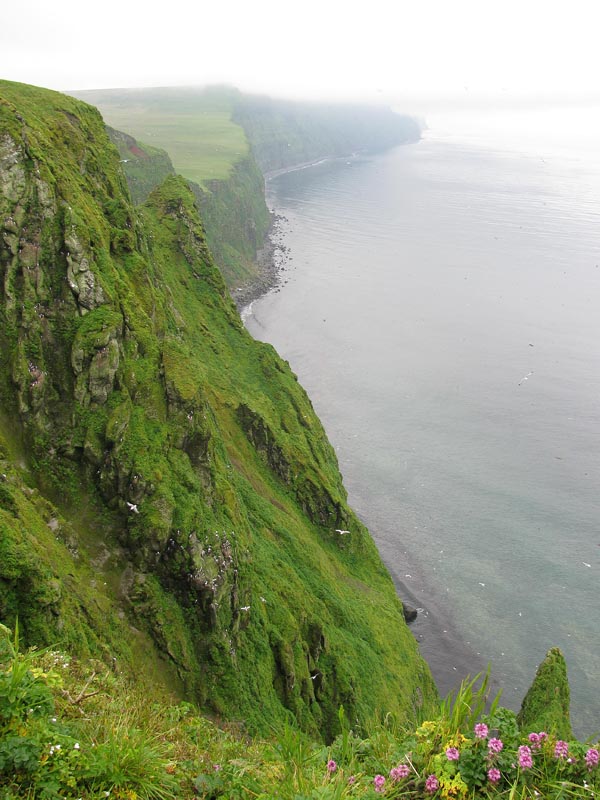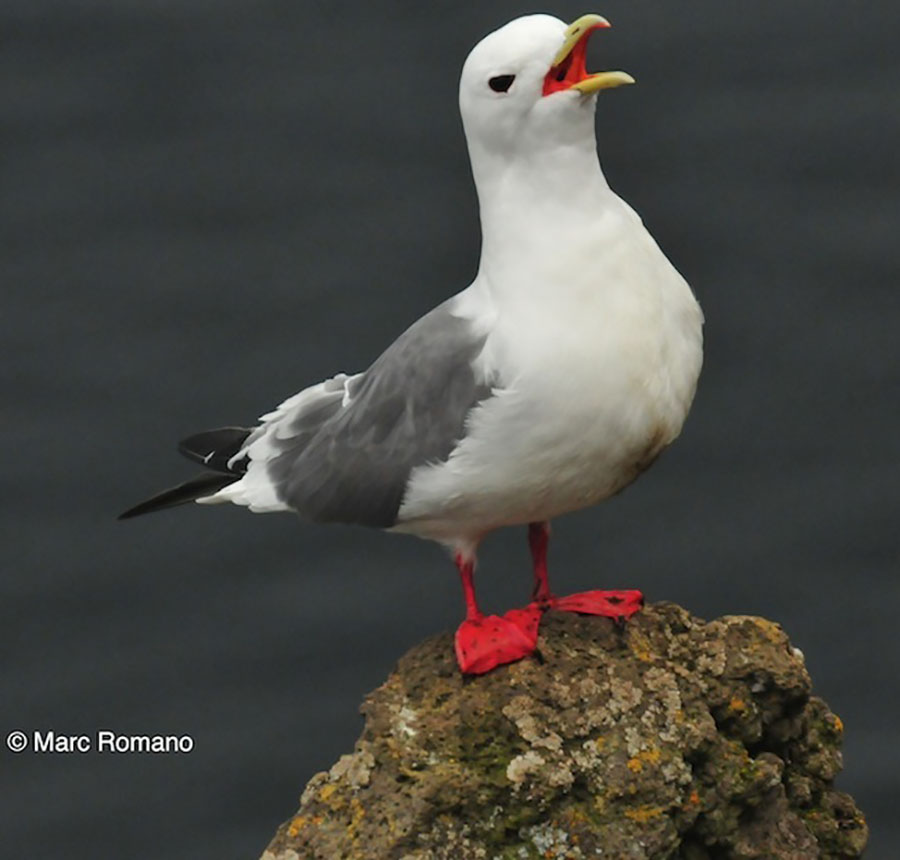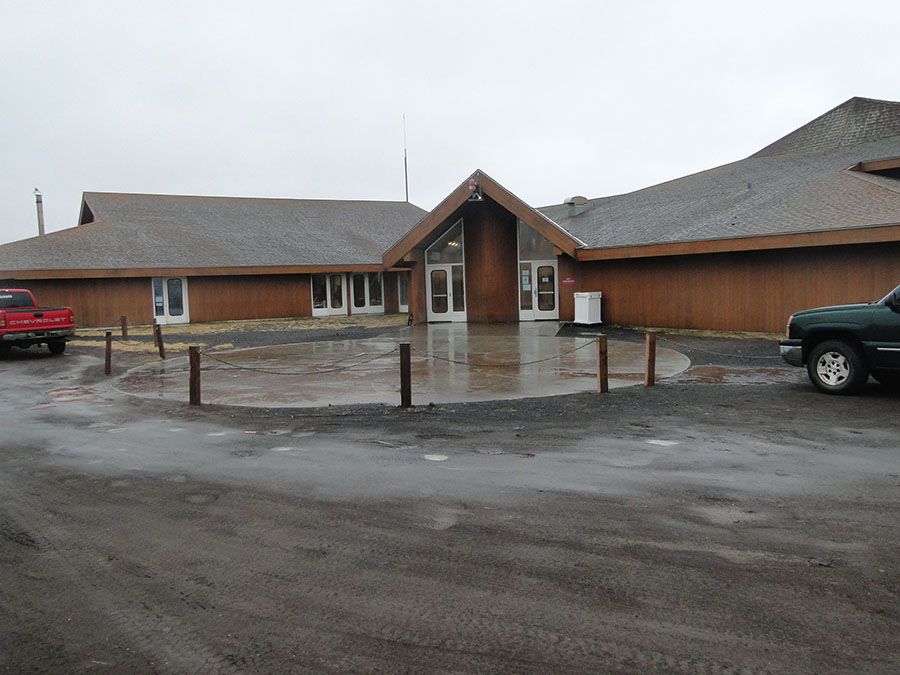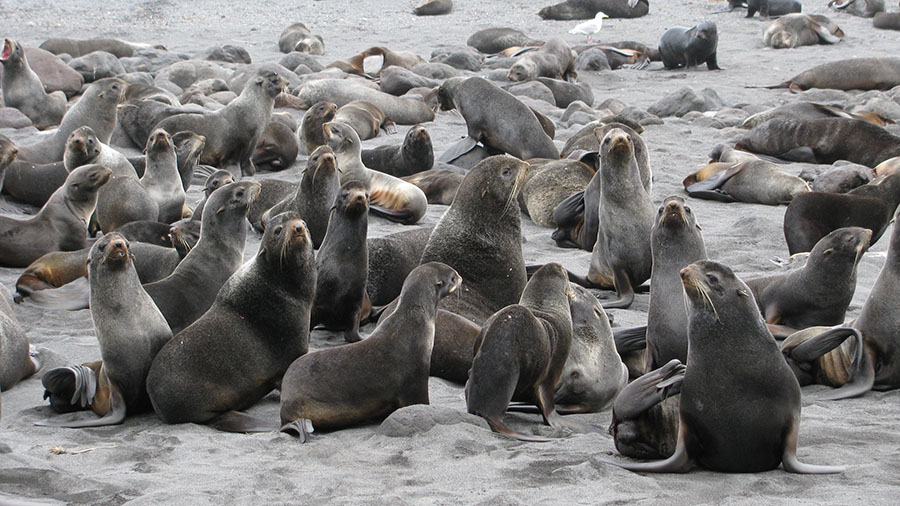 About the Pribilof Islands
About the Pribilof Islands
The Pribilof Islands are a remote group of volcanic islands in the Bering Sea, about 200 miles north of Unalaska, and about 500 miles southeast from the Russian coast. There are two large inhabited islands (St. Paul and St. George), and three small outer islands (Otter Island, Walrus Island, and Sealion Rock). The total area of the Pribilof Islands is about 75 square miles. The Pribilof Islands are part of a marine ecosystem, with a sub-arctic climate and mean temperatures of 19-52 degrees Fahrenheit. Coastal waters are generally open throughout the year, with pack ice only occasionally reaching the island during winter months.
The Pribilofs have exceptional wildlife. A good proportion of the world’s population of Northern Fur Seals breed here during the summer months, and an estimated 2. 8 million seabirds nest on the islands. Seabird species include Common Murres, Thick-billed Murres, Red-legged Kittiwakes, Black-legged Kittiwakes, Horned Puffins, Tufted Puffins, Least Auklets, Parakeet Auklets, and Crested Auklets. Due to the importance of these seabird colonies, the islands were included in the Alaska Maritime National Wildlife Refuge in 1984. In addition to the rich marine ecosystem, terrestrial mammals include the endemic Pribilof Island shrew on St. Paul, lemmings on St. George, and reindeer (introduced from Western Alaska) and the Arctic fox on both islands.
Gavrill Pribilof, a Russian navigator searching for the breeding colonies of fur seals, was the first westerner to set foot on the Pribilof Islands in 1786. Legend has it that the loud noise of the fur seals led the sailors through the thick fog to St. George Island. The Russians created fur-seal harvesting settlements on St. Paul Island and St. George Island in the 1820s, and Aleuts were forcibly taken from the Aleutian Islands to be laborers.
The Pribilof Islands were sold to the United States in 1867. However, although the sale of fur seal pelts remained a highly lucrative business, the Aleut people were only paid in kind for their hard work in the seal harvest and faced discrimination at the hands of the government agents. The Aleut people were evacuated from the Pribilofs and sent to Southeast Alaska during World War II. The Aleuts eventually gained more control with the 1971 Alaska Native Claims Settlement Act. Village native corporations were started on both St. Paul Island and St. George Island, and the town governments became more established. St. Paul has a current population of about 480, and St. George has a population of about 100.
Commercial seal harvesting stopped on St. George in 1973 and on St. Paul in 1984 because of the declining fur seal numbers and pressure from animal protection groups. Although there is no commercial harvest today, subsistence harvesting continues, with seals taken for food on both islands by Aleut people.
“People of the Seal” is a beautifully filmed movie that explores the connection between the northern fur seal and the Unangan natives of Alaska’s Pribilof and Aleutian Islands in the middle of Alaska’s Bering Sea. Aquilina Lestenkof traces five generations of her own family’s history.
Pribilof Seabirds
 The Pribilof Islands come alive each summer with the sights and sounds of seabirds. An estimated 2.8 million seabirds return to the islands each year to lay their eggs and raise their chicks. Seabird species include the Common Murre, Thick-billed Murre, Red-legged Kittwake, Black-legged Kittiwake, Horned Puffin, Tufted Puffin, Least Auklet, Parakeet Auklet, Crested Auklet, Northern Fulmer, and the Red-faced Cormorant. The Pribilofs are an especially important location for the Red-legged Kittiwakes, with 80% of the world’s population breeding on the islands. The are only a few other places that Red-legged Kittiwakes breed including Buldir and Bogoslof Island (in the Aleutian Islands) and the Commander Islands. Due to the global importance of the Pribilof seabird colonies, the islands were included in the Alaska Maritime National Wildlife Refuge in 1980.
The Pribilof Islands come alive each summer with the sights and sounds of seabirds. An estimated 2.8 million seabirds return to the islands each year to lay their eggs and raise their chicks. Seabird species include the Common Murre, Thick-billed Murre, Red-legged Kittwake, Black-legged Kittiwake, Horned Puffin, Tufted Puffin, Least Auklet, Parakeet Auklet, Crested Auklet, Northern Fulmer, and the Red-faced Cormorant. The Pribilofs are an especially important location for the Red-legged Kittiwakes, with 80% of the world’s population breeding on the islands. The are only a few other places that Red-legged Kittiwakes breed including Buldir and Bogoslof Island (in the Aleutian Islands) and the Commander Islands. Due to the global importance of the Pribilof seabird colonies, the islands were included in the Alaska Maritime National Wildlife Refuge in 1980.
Прибыловские морские птицы
Каждое лето, Прибыловские острова просыпаются при виде и крике морских птиц. Считается, что приблизительно 2,800 000 морских птиц возвращаются каждый год на островах, чтобы откладывать яйца и разводить птенцов. Виды морских птиц включают тонкоклювую кайру, толстоклювую кайру, красноногую говорушку, обыкновенную моевку, рогатого тупика, топорика, малую конюгу, белобрюшку, глупыш, и краснолицого баклана. Прибыловские острова являются особенно важными для красноногой говорушки, поскольку 80% мировой популяции этой птицы размножается на островах. Единственные другие места, где они размножаются включают острова Булдир и Богословский (на Алеутских островах) и Командирские острова. Учитывая глобальную значимость птичьих базаров на Прибыловских островах, острова включили в Аляскинский морской заповедник в 1980 г.
The Refuge

The National Wildlife Refuge System is a major part of the U.S. Fish and Wildlife Service (a US Government agency). Refuges manage a national network of lands and waters set aside to conserve America’s fish, wildlife, and plants. The Alaska Maritime National Wildlife Refuge (AMNWR) contains 3.4 million acres that provides essential habitat for about 40 million seabirds, including more than 30 species. Due to the global importance of their seabird colonies, the Pribilof Islands were included in AMNWR in 1980. Each summer 3-6 Refuge biologists visit the Pribilof Islands to monitor the breeding seabirds. These biologists are interested in detecting and understanding any long-term changes in the local seabird populations. Each year, the biologists spend hours sitting on the cliffs counting the birds to monitor population sizes. They also record how many eggs and chicks the seabird parents manage to produce each year. This measure of productivity or breeding success gives biologists an idea of how well the seabirds are doing each year. Many things could affect the breeding success of seabirds, such as weather or local food availability. Students on the Pribilof Islands are learning how and why the Refuge biologists are monitoring seabirds through the Seabird Youth Network.
Заповедник
Cеть национальных природных заповедников является главным компонентом услуг Рыбы и Дикой природы США (агентство правительства США). Заповедники управляют отечественной сетей земных и водных участков, предназначены для охраны рыб, животных и растений в Америке. Аляскинский национальный морской заповедник охватывает 13 700 км2, и является важнейшим обитанием для более 40 миллионов морских птиц, представляющих 30 разных видов. Учитывая, что эти базары считаются очень важными на всемирном уровне, Прибыловские острова включили в территорию заповедника в 1980 г. Каждое лето, от 3 до 6 биологов, работающих для заповедника, приезжают на Прибыловские острова, чтобы следить за размножением морских птиц. Биологи интересуются в том, чтобы определить и понимать любые долгосрочные изменения в местной популяции морских птиц. Каждый год, биологи часами сидят на скалах и водят счёт птиц, для слежения их численности. Они тоже записывают, сколько яйц и птенцов у каждой родительской пары морских птиц в год. Это измерение плодотворности или размножения помогает биологам получить представление о том, здоровы ли популяции морских птиц на ежегодной основе. Многое может влиять на успех морских птиц размножаться, например погода или местная корма. Школьники на Прибыловских островах учатся о том, почему и как биологи заповедника следят за морскими птицами, в рамках Молодëжной cети о морских птицах.
Airport
On the Pribilof Islands, the transportation we mainly use is Pen Air, also known as Peninsula Airlines. The plane tickets cost a minimum of eight hundred dollars, but usually eleven hundred dollars for a round trip ticket. Pen Air does passenger and cargo service, charters, and medevac services. Pen Air has a website which is https://www.penair.com/ where you can make reservations and do online check-ins. You can also check the flight status on the website. The website can tell you about how Pen Air was founded by a man named Orin Seybert, under the categories of “Get To Know Us” and “Our Story”. Pen Air is the second largest commuter airline that services small villages around Alaska. Pen Air runs small planes that seat about 30 people, and the trip from the Pribilofs into Anchorage takes about 3 hours.
Аэропорт
На Прибыловских островах, главное средство транспорта – авиакомпания Пэн Эр, т.е. Пэнинсюла Эрлайнс. Самолетные билеты стоят как минимум восемь сот долларов, но чаще всего тысячу сто долларов, для билета в два конца. Пэн Эр доставляет пассажиров и груз, организует чартеры и транспортно-санитарные операции. У компании есть веб сайт
www.penair.com, который можно посещать, чтобы заказать билеты и провести регистрацию. Можно тоже проверять на том же сайте летит ли самолёт. Сайт рассказывает в секциях «о нас» и «наша история», как компанию Пэн Эр создал человек по имени Орин Сейберт. Пэн Эр – вторая по размере авиакомпания, которая обслуживает небольшие села вокруг Аляски. У неё малая авиация, которая размещает 30 пассажиров в самолётах, и рейс от Прибыловских островов до Анкориджа длиться около 3-х часов.
School

Here on St. Paul Island we have a small village school named Saint Paul Island School, which is part of the Pribilof School Distract. The number of students we have in the school is about seventy-five. That is K-12 (ages 5-17 years)! Although we do offer high school courses, each year some students go to attend Mount Edgecumbe High School instead of staying here for High School. Mount Edgecumbe is boarding school in Southeast Alaska. Mt. Edgecumbe is larger and can offer a more diverse curriculum.

On St. George Island, the school only has 10 kids in K- 8th grades! The sports we play here are Basketball, Volleyball, Softball, and Kickball. Another special thing about our school is that the St. Paul School mascot is a Puffin! In the Seabird Youth camp we learn about the seabirds -especially about the Puffin. We also learn about Seabirds in school using the Seabird Youth curriculum and from mentor scientists who come for Bering Sea Science Days.
Школа
На острове Св. Павла в селе находится маленькая школа, называемая Школа острова Св. Павла, которая входит в школьный район Прибыловских островов. Численность школьников – около 75, включая все классы от 5 до 17 лет возраста. Несмотря на то, что в школе нет курсов средней школы, некоторым школьникам время от времени появляется возможность провести год в интернате Маунт Эджкум, вместо того, чтобы остаться на острове для средней школы. Интернат Маунт Эджкум находится в южно-восточной части Аляски, и является гораздо больше школой с разными программами. На острове Св. Георгия, только 10 детей записаны в школе от детского сада до 8-го класса. Здесь занимаются спортом, в особенности баскетбол, волейбол, софтбол и кикбол. Символ спортивной команды в школе Св. Павла – топорик! В молодёжном лагере о морских птицах, мы учимся о морских птицах, в том числе и о топориках. Мы тоже учимся о них в школе в программе о морских птицах и когда мы работаем с ученными наставниками, которые приезжают сюда для программы «Дни Науки в Беринговом море».
Fur Seals

St. Paul Island is home to one of the largest populations of breeding northern fur seals, about 600,000. The fur seal’s history and the St. Paul Aleut people’s history are tied closely together. Historically, there were into the millions of fur seals that came to the beaches and rocky shores of the island to breed. Aleut people from the Aleutian Chain were brought to the Pribilof Islands by the Russian fur traders to commercially harvest the pelts of the seals. The commercial harvests have stopped, and there is only a small subsistence harvest allowed each summer. Many local people depend on fur seal meat as a meat source for the long winter months.
Котики
На острове Св. Павла живёт одна из крупнейших популяций северных котиков, численность которых достигает около 600 000. История котика и история алеутского народа на острове Св. Павла тесно связаны. В прошлом, миллионы котиков приплывали к пляжам и скалам острова в сезоне размножения. Русские промышленники переселили алеутов из Алеутских островов на острове, чтобы заниматься промыслом котиков. Промысел теперь прекратился, и разрешается только ограниченная охота каждое лето для коренного населения. Многие местные жители зависят от мяса котика в течение длинной зимы.
Harbor
![St. Paul Harbor overview[1]](https://seabirdyouth.org/wp-content/uploads/2014/03/St.-Paul-Harbor-overview1.jpg)
The St. Paul harbor is an important part of our island. Much of our economy is based on fishing. Our local fishermen have a fleet of small boats (18-30 footers on average) that they use for catching halibut on long lines. Our fishermen also are able to “Jig”, or fish by hand lines, to catch halibut for subsistence. The fishermen will share their subsistence catch throughout their families and community members. Another important fishery for St. Paul Island is the Crab. Large crab boats come from many other homeports to catch King and Opilio crabs. Trident is the processing company that runs a plant seasonally at our harbor.
Порт
Порт Св. Павла – существительная часть острова. Большая часть экономики зависит от рыбного промысла. У наших рыбаков флот небольших судов (в среднем от 6 до 10 метров длины), на борту которых они занимаются ярусным ловом палтуса. Наши рыбаки тоже ловят палтус на поддев для традиционного промысла. Они делят рыбу с своей семьей и жителями села. Другой важнейший промысел для острова Св. Павла – краболовный промысел. Большие краболовные суда приезжают сюда от разных портов в США, чтобы поймать королевского краба или краба-стригуна. Компания Тридент имеет завод переработки рыбы и краба, которая работает в нашем порту во время промысла.
General Wildlife

In addition to fur seals and seabirds, St. Paul is home to a small herd of reindeer that are also used for subsistence meat in the community. We have our own subspecies of the Arctic Fox that are mostly the dark colored pelts. These foxes found their way here to St. Paul on the ice pack historically. At one time in history, the there was a fox farm operation and the pelts were sold. This no longer happens. Aside from some small songbirds, the Pribilof shrew, and many wildflowers, the only other wildlife we have is the occasional whale that swims by.
Общие сведения о природе
Кроме котиков и морских птиц, на острове Св. Павла тоже живёт небольшое стадо северных оленей, от которого село доставляет мясо. У нас тоже имеется подвид песца, с преимущественно темной шкурой. Эти песцы давно перебрались по льду до острова. Когда-то здесь работала звероферма, и пушнину вывозили. Но этого больше нет. За исключением певчих птиц, прибыловской землеройки и многих диких цветов, единственное другое животное, которого мы видим время от времени – киты, которые проплывают мимо острова.
